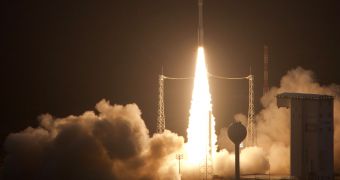At 07:00 local time, the first Vega light-lift delivery system launched successfully from the Kourou Spaceport, in French Guiana, South America. The rocket was commissioned by the European Space Agency (ESA), which now finally has all payload mass segments covered.
Small satellites will from now on be launched aboard Vega rockets, medium-class payloads from Russian-built Soyuz capsules and rockets (which can also take off from their dedicated pad at Kourou), while larger satellites will be delivered via the Ariane 5 delivery system.
Officials at the European organization were ecstatic to see the rocket soar to the skies at 1000 GMT (11:00 CET), carrying nine small satellites as initial payload. The launch has been planned for months, and all tests gave Mission Control a green light earlier today.
The first Vega qualification flight went flawlessly, an ESA press release indicates. The project to build the new rocket began in 2003, and was conducted with the support of Belgium, France, Italy, the Netherlands, Spain, Sweden and Switzerland.
“Today is a moment of pride for Europe as well as those around 1000 individuals who have been involved in developing the world’s most modern and competitive launcher system for small satellites,” said the ESA Director of Launchers, Antonio Fabrizi.
“ESA, with the technical support of the Italian and French space agencies, and about 40 industrial companies coordinated by the prime contractor ELV SpA, have made this enormous challenge a reality in under a decade of development,” he went on to say.
Vega is capable of carrying satellites weighing between 300 and 2,500 kilograms (660 to 5,512 pounds). The cargo can be deployed in numerous types of orbits, ranging from Sun-synchronous to equatorial and geostationary.
Primarily, the delivery system was developed around the need to put 1,5-tons (3,300-pound) spacecraft into a circular, Sun-synchronous orbit, at an altitude of about 700 kilometers (435 miles).
“In a little more than three months, Europe has increased the number of launchers it operates from one to three, widening significantly the range of launch services offered by the European operator Arianespace,” ESA Director-General, Jean-Jaques Dordain, said after the launch.
“There is not anymore one single European satellite which cannot be launched by a European launcher service. It is a great day for ESA, its Member States, in particularly Italy where Vega was born, for European industry and for Arianespace,” he concluded.

 14 DAY TRIAL //
14 DAY TRIAL //